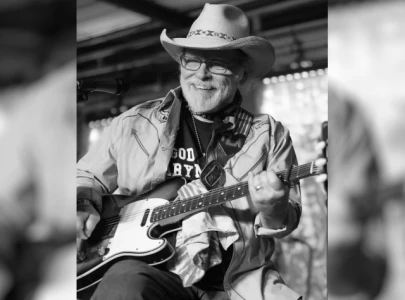The end of Ramazan is upon us and with Eid just around the corner, bazaars are rife with eager shoppers preparing for the festivities. While some are stocking up on groceries, others are hopping from tailor to tailor in the hopes of getting last-minute alterations done to their joras. But as always, many of us are still clueless about what to wear on Eid. With a string of Eid exhibitions taking place, it’s a challenge to decide what trends to follow for the season. And with so much variety on offer, who can blame us? As we look ahead to see what trends will shape this festive occasion, let’s look back at how sartorial choices for Eid have evolved every Ramazan.

With cultural influences dictating shifts in aesthetic preferences, we’ve witnessed a myriad of Eid trends over the past four to five decades. The 1970s and 80s boasted vibrant brocades, silk, jacquard, Chantilly laces and kamdani, which remain a fond memory for many, such as designer Faiza Samee. “Back then, Eid clothing had to be very formal. So, if we ever failed to have something new stitched, we could simply don an outfit from a cousin’s wedding,” she says. Hemlines were more conservative, wavering right above or below the knee. Paired with heavy dupattas, featuring gotta patti, mirrors, and ari and zari work, the trends granted the entire decade a gleam like no other.

The 80s also saw an influx of colourful patterns, shimmery fabrics, chooridar pajamas, anarkalis, and angrakha panel shirts, which lost their lustre towards the end of the decade. As the average Pakistani woman became more career-oriented, the looks became more muted. Baggy Patiala shalwars, for instance, were replaced by sleek culottes and trousers, both of which have made comebacks recently.
As we set foot in the 90s amid growing forces of globalisation, Eid attire evolved once again. Not only did designers from other countries influence what the locals wore but young and trained fashion experts emerged to the fore in Pakistan as well, reinvigorating the industry. They introduced silhouettes, cuts and intricate embroideries never seen before, putting works, such as tilla, naqshi and gotta, on the back burner. Diamantes, semi-precious stones and Swarovski crystals became popular embellishments and remain so to date.
Even jewellery preferences changed with time and finally, after decades of donning gaudy jewellery and sets of bangles on Eid, women begun opting for something a little different. Many women, who once ran to the bank to retrieve their chand baalis, jhumkaas and pearls, now opt for statement pieces alone. “The pendant necklace has made a comeback, updating current jewellery trends,” shares jewellery designer Sherezad Rahimtoola. “Just one piece is much more popular now, be it a bracelet, earring or locket. A bit of gold is okay but bangles are completely out,” she added.

In today’s Pakistan, women are leading busy lives, so they prefer a chic yet minimalist wardrobe for occasions, such as Eid. According to Faiza, fashion these days is much more distinctive in its use of colours, cuts and embroideries. “I’m probably the only designer encouraging shalwars in a modern, innovative combination as part of Eid formals. Shalwar kameez is essentially the only living traditional attire, which evolves and influences latest trends,” she explains.
Like Faiza, the current crop of designers often draws inspiration from the past and simply modifies the traditional looks, keeping the spirit of Eid intact. The only Eid trend that has seemingly stood the test of time and retained its original essence is the crisp white shalwar kurta — the go-to solution for most Pakistani men, especially in the blazing heat. Fashion guru Amir Adnan, who claims to have reintroduced traditional menswear, agrees with Faiza. “No matter how much fashion evolves, the white shalwar kurta will always be in vogue,” he notes.

Amir and his brand work to combine elements of Pakistani culture, juxtaposing them with modern silhouettes. “When I create an Eid kurta, I picture a man wearing it for namaz, family gatherings and formal dinners. With time, I have included embroidery, embellishments and different colours. Waistcoats have also come back and sparked a new era in menswear,” he shares. Owing to the influence of Bollywood on the local fashion scene, most waistcoats are available in vibrant hues and flashy patterns.
Fortunately for us, the sky is the limit when it comes to fashion. Our complaints about having nothing to wear may be longstanding, but it shouldn’t matter what cut suits us best or what colour we stand out in, so long as our joras reflect the gloriously rich Pakistani aesthetics and celebratory nature of Eid.
Published in The Express Tribune, July 15th, 2015.
Like Life & Style on Facebook, follow @ETLifeandStyle on Twitter for the latest in fashion, gossip and entertainment.

1724238420-0/Untitled-design-(3)1724238420-0-165x106.webp)

1731678234-0/pete-(1)1731678234-0-165x106.webp)


1731671399-2/Express-Tribune-(12)1731671399-2-270x192.webp)
1731657220-1/Express-Tribune-(6)1731657220-1-270x192.webp)
1731654835-0/Express-Tribune-(5)1731654835-0-270x192.webp)








COMMENTS
Comments are moderated and generally will be posted if they are on-topic and not abusive.
For more information, please see our Comments FAQ